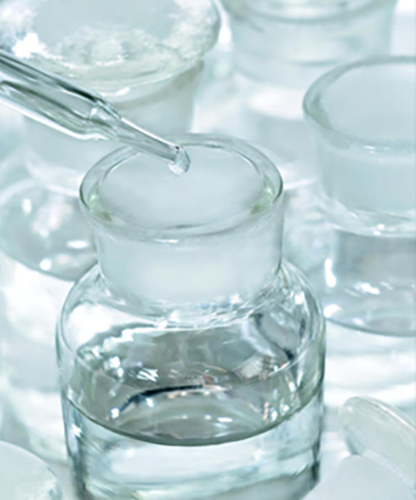Unique properties of thiophene
Introduction
Thiophene, systematic name 1-thia-2,4-cyclopentadiene, CAS number 110-02-1. From the structural point of view, thiophene is a heterocyclic compound and a thioether. Molecular formula C4H4S, molecular weight 84.14. Melting point -38 ℃, boiling point 84 ℃, density 1.051g/cm3. At room temperature, thiophene is a colorless, foul-smelling, tear-inducing liquid. Thiophene occurs naturally in petroleum, in concentrations as high as several percent. Industrially, it is used for the denaturation of ethyl alcohols. Like furans, thiophenes are aromatic. One of the two pairs of lone electrons in the sulfur atom is conjugated with two double bonds, forming a delocalized Π bond. Thiophene is only slightly less aromatic than benzene[1].

Picture 1 Thiophen liquid
Physical properties of thiophene
Thiophene is a five-membered heterocyclic compound containing a sulfur heteroatom. Molecular formula C4H4S. Exist in coal tar and shale oil; in crude benzene and crude naphthalene obtained by fractional distillation of coal tar, crude benzene contains about 0.5%. Colorless, unpleasant odor liquid. The melting point is -38.2°C, the boiling point is 84.2°C, and the relative density is 1.0649 (20/4°C). Since its boiling point is 84°C, which is close to benzene, it is difficult to separate them by distillation. Soluble in alcohol, ether, acetone, benzene, etc.
Chemical properties of thiophene
It is a colorless fluid liquid with an aromatic odor similar to benzene. Flammable. Toxic. Absorption through skin or inhalation of vapors can cause poisoning. Contact with strong oxidants is prohibited. Like benzene, thiophene can undergo nuclear substitution reactions such as alkylation, sulfonation, nitration, halogenation, cyanation, and chloromethylation. Thiophene is aromatic, similar to benzene, and more prone to electrophilic substitution reaction than benzene, mainly substituted at the 2-position. The hydrogen on the 2-position of thiophene is also easily substituted by metals to generate derivatives such as mercury and sodium. The thiophene ring system has certain stability to oxidizing agents, for example, alkyl-substituted thiophenes can be oxidized to form thiophene carboxylic acids. Dihydrothiophene and some ring-opening compounds can be obtained by reducing thiophene with metallic sodium in liquid ammonia and methanol solution. Reduction of thiophene by catalytic hydrogenation yields tetrahydrothiophene. In industry, thiophene is prepared from butane and sulfur. In the laboratory, thiophene is prepared by reacting 1,4-dicarbonyl compounds with phosphorus trisulfide. Acetyl butanone reacts with phosphorus sulfide to generate 2,5-dimethylthiophene. Thiophene can replace benzene in many occasions as a raw material for making dyes and plastics, but because of its more active properties, it is generally not as good as products made from benzene. Thiophene can also be used as a solvent.
Preparation of thiophene by extraction
Thiophene exists in the crude benzene fraction produced by coking and is a tar impurity. Because the boiling points of thiophene and benzene are close, it is difficult to separate the two by ordinary fractional distillation. Solvent extraction method.
The hydrorefining method has high cost and large investment, and is not advisable for industrial production; the sulfuric acid method has serious pollution, low yield, and difficult post-processing, and is also a backward process. A small number of coking plants use this method to produce a small amount of thiophene; The yield is high, the product purity is high, and it is suitable for large-scale production.
Process for preparing thiophene in industry
Industrially, thiophene is prepared by the action of butane and sulfur. Butane is first dehydrogenated, and then ring-closed with sulfur to form thiophene. In the laboratory, thiophene is prepared by reacting 1,4-dicarbonyl compounds with phosphorus trisulfide. Acetyl butanone reacts with phosphorus sulfide to generate 2,5-dimethylthiophene.
If the thiophene cannot be extracted and refined well, limited resources will be wasted and serious pollution will be caused to the environment. In many chemical syntheses using benzene as a solvent, the presence of trace amounts of thiophene will seriously affect the product quality and even scrap it.
The world's first industrial plant for the production of thiophene adopts the gas-phase catalytic process of butane and sulfur (nobiloil method, developed by Soccong-Vaccum Company), with a yield of 40%. Low, serious equipment corrosion, environmental pollution and stop production. The newer methods are: 1. Gas-phase catalysis method, by continuously reacting butene, butadiene, n-butanol, butenal with carbon disulfide or sulfur dioxide in the presence of an alkali-promoted metal oxide catalyst at 500 °C to obtain thiophene and its thiophene. Derivatives; ② by reacting furan or methylfuran with carbon disulfide under the catalysis of heteropoly acid at 400 ℃ to prepare thiophene and methylthiophene, the yield can reach 93%, the catalyst has a long life, no need for periodic regeneration, it is a promising 3) Butane is mixed with sulfur in gas phase, and reacts rapidly at 600°C; 4) In the presence of iron oxide, acetylene is reacted by pyrite heated to 300°C; 5) Anhydrous sodium succinate and phosphorus trisulfide are Reacts at high temperature and in a stream of carbon dioxide.
Reference
1 Bak B, Christensen D, Hansen-Nygaard L, et al. The structure of thiophene[J]. Journal of Molecular Spectroscopy, 1961, 7(1-6): 58-63.
Related articles And Qustion
Lastest Price from Thiophene manufacturers

US $20.00/kg2025-04-21
- CAS:
- 110-02-1
- Min. Order:
- 1kg
- Purity:
- 99%
- Supply Ability:
- 10 mt

US $0.00-0.00/KG2025-01-03
- CAS:
- 110-02-1
- Min. Order:
- 1g
- Purity:
- 99%
- Supply Ability:
- 2000tons




